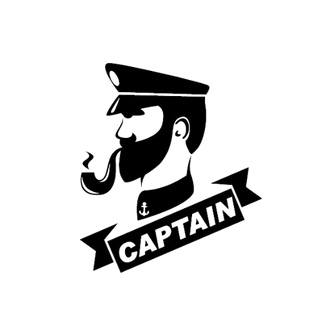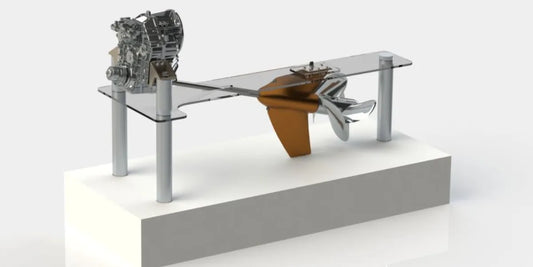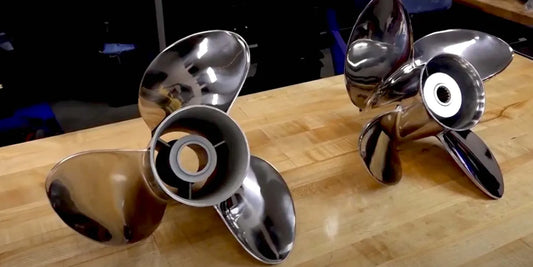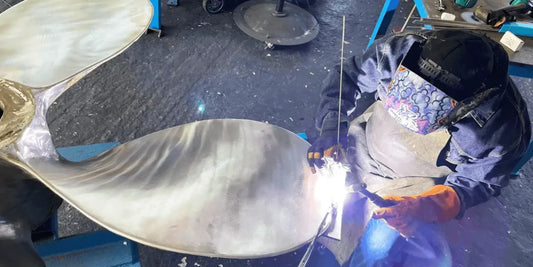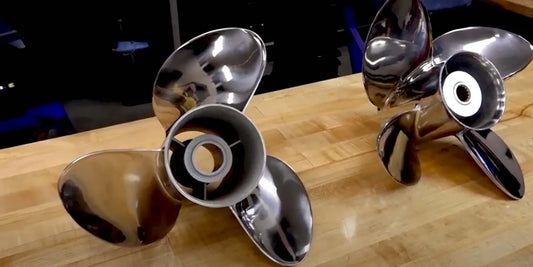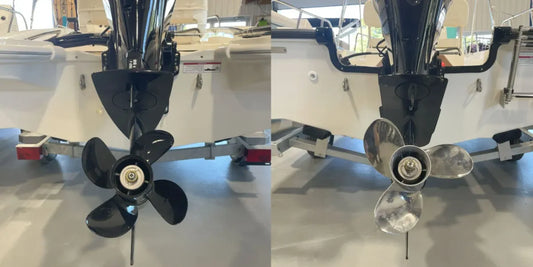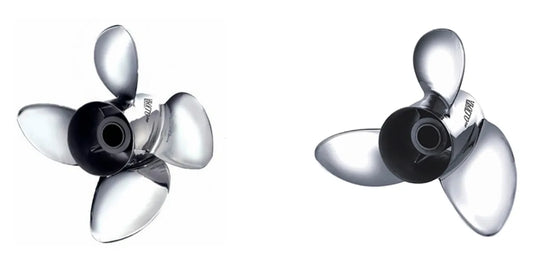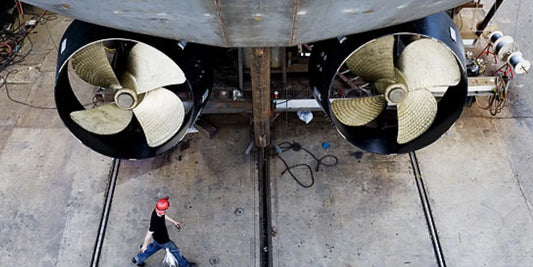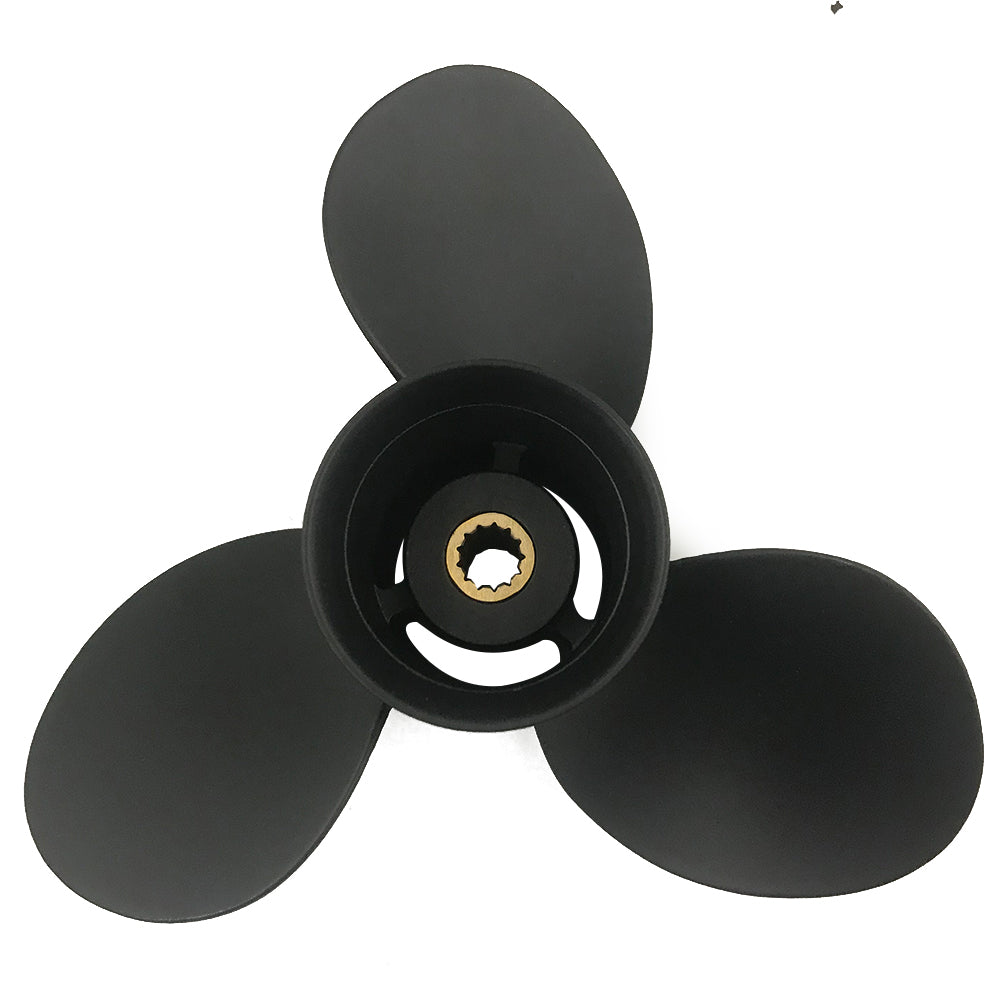When it comes to enhancing the performance of your vessel, every little detail matters - a 3-blade versus a 4-blade propeller. Whether it is implementing faster speed, better fuel economy, or efficient handling in challenging waters, the characteristics of a given propeller type must be clearly understood. This guide will delve into the key differences, pros, and cons of choosing propellers for your specific needs. By identifying the benefits that each type offers, a more informed decision can be made, ultimately enhancing your entire boating experience. Read further to explore how your time on water can rise with the right blade propeller.
Understanding Propeller Basics

What is a Propeller?
A propeller is a machine that produces thrust by the conversion of rotational motion into a forward or backward force. This could be blades extended out from a central hub and shaped in such a way as to act efficiently on air or water. With the rotation of the propeller, the blades create a difference in pressure on either side that pushes the vehicle, exemplified by a boat or aircraft, through its surroundings. Other important parameters that define the workings of a propeller include the number of blades, pitch, diameter, and material composition. Meanwhile, a propeller with a higher pitch would cover more distance per rotation and is considered the better option for speed. Conversely, lower-pitch propellers are better suited for towing and handling heavy loads. So, knowing these details would go far in enabling one to have an optimized performance and hence operate at utmost efficiency with his vessel.
Categories of Propellers: An Overview
Propellers are categorized into different types based on their design, use, and performance criteria. These are classified under fixed-pitch, variable-pitch, contra-rotating, and ducted propellers, with each type serving a special purpose according to its specifications.
Fixed-Pitch Propellers:By definition, fixed-pitch propellers have blades set at one angle, and hence, from the standpoint of design, they are very simple and durable. These propellers are typically used for smaller boats and are suitable for certain types of operations where speed changes under varying loads are not crucial. Less maintenance is required for fixed-pitch propellers, as there are no mechanical adjustments that can go wrong.
Variable-Pitch Propellers: With variable-dimensional blades, the blades can be manipulated even during operation to condition the working performance of the propeller under carefully assessed conditions. This, in turn, will yield maximum efficiency and applicability to any situation involving changing speed or load requirements, such as commercial shipping and aviation.
Contra-rotating Propellers: This type features two propellers mounted on the same axis, but they rotate in opposite directions. Contrarotating propellers reduce turbulence-induced energy loss, producing higher thrust and efficiency. These are usually used in advanced marine applications and high-end systems.
Ducted Propellers: A ducted propeller is a nozzle-propeller with the propeller encased in a cylindrical duct, which provides better thrust at lower speeds. Well-suited for tugboats and submarines, its ducted design provides excellent maneuverability and efficiency in heavy-duty applications.
Depending on the speed requirement, load characteristic, or working condition, an appropriate type of propeller must be selected. Recent advancements in materials and design optimization further enable good propeller performance, making them more efficient and customized to specific needs.
Blade Design Significance
Blade features hold the highest importance in the acceptance of propeller design and in its actual working potential. The blade design varies from size to shape, angle, and set number, depending on how well it can best absorb and convert turned energy to thrust. For heavy loads and pulling power, generally, a big-sized blade geometry with a low pitch angle is preferred. In contrast, for high speeds, small-sized blades with high pitch angles are used. Then, with the advent of CFD and the latest developments in material sciences, the engineers began to calculate the blade design most carefully and then optimize it for the given work, thus ensuring minimized energy loss and noise along with maximum efficiency from the blade. It has been determined that streamlined blade shapes and special coatings help reduce drag and cavitation, further improving efficiency in operation and life expectancy of the blades.
3 Blade vs 4 Blade Prop: Key Differences

Performance Characteristics of 3-Blade Propellers
The three-blade propellers are widely accepted as being perfectly balanced for the diverse array of applications they serve. These propellers are the most common choice among recreational vessels and some commercial operations, as they tend to offer a good compromise between speed, thrust, and fuel consumption. These propellers provide for smooth handling and responsive acceleration as they are designed to reduce drag and maximize rotational efficiency.
By virtue of having a smaller surface area, 3-blade propellers encounter less resistance through the water, allowing them to achieve greater speed most of the time compared to 2- or 4-blade propellers, which have wider blades. 3-blade propellers are most effective at higher RPM, offering improved efficiency, responsiveness, and stability. This means that the majority of boats should cruise faster without compromising the turning ability.
Progression in blade geometry and materials has significantly enhanced the durability and performance of triple-blade designs. Modern computer simulations, along with precision manufacturing techniques, have enabled the most optimal weight distribution and cavitation resistance, thereby significantly protecting the entire propulsion system from undue stress. However, given the decreasing speed, the finer thrust by the fewer blades theory does come into play, thus, at the low end of the velocity, they will find less thrust compared to 4-bladed propellers, which could be a consideration in heavy-displacement or towing-work scenarios.
Advantages of 4 Blade Propellers
Due to the specific benefits 4-blade propellers provide during operation, they have been favored for multiple marine applications. Their thrust is further advantageous in the lower range of the speed spectrum, particularly suited to heavy displacement vessels or those engaged in towing activities. That is to say, the vessels are easier to handle in rough waters or upon demand when load-bearing enhancements are required.
Additionally, these 4-blade propellers also reduce vibrations and noise, resulting in improved stability and smoother operation. Due to these factors, they are ideal for recreational boats where passenger comfort is a priority. They also exert more grip on the water and usually allow quicker acceleration and better maneuvering, an invaluable trait in occasions such as water sports or tight docking in marinas. Design and materials advancement nowadays, however, allows 4-blade propellers to keep high fuel efficiency still while also managing to perform better. This versatility makes them reliable in various environments.
Blade Count vs. Speed and Efficiency: A Study
A propeller's blade count also plays a vital role in speed and efficiency. Generally speaking, fewer blades mean higher speeds since there is less drag on the propeller moving through the water. For instance, 3-blade propellers are built for the utmost in speed by offering the least resistance to their movement and, therefore, are employed for high-speed boats. More blades mean more thrust and stability, such as 4 or even 5-blade propellers, which work well for boats that carry heavy loads or are subjected to rough waters.
The premise for a wind turbine design is that a 3-blade propeller may achieve slightly higher peak speed differences, while a 4-blade unit generally attains better fuel efficiency at a smooth performance in constant speeds. Practical testing data in maritime environments has indeed shown that a well-crafted 4-blade prop is capable of reducing vibrations and improving mid-range performance by spreading the load more evenly across the extra blade. This results in a fairly balanced speed without overburdening the engine, which is beneficial for both durability and operational efficiency.
Hence, the blade count really depends on the specific needs of the vessel and other operating conditions it would usually encounter. An understanding of these trade-offs will then enable boaters to choose the configuration that is most suitable to the speed and load they require and desire in performance.
Choosing the Right Prop for Your Boat

Factors to Consider When Selecting a Blade Propeller
An ample number of considerations should go into maximizing optimization and efficiency of a blade propeller, and with size being primarily top on the list, the two most significant properties that need to be worked upon are diameter and pitch. If the diameter is big, the thrust generated will be more, while the increase in pitch will mean the boat will move farther ahead in each rotation. If sizes are not correctly balanced, then the boat will either move too slow or will consume excess fuel energy at the desired speed.
Materials constitute another significant factor. A propeller can be constructed from aluminum, stainless steel, or composites. Aluminum propellers are less costly and weigh less; yet, they do not perform well under adverse conditions. Stainless steel propellers fare far better and come with greater performance but they do tend to cost more. Composite propellers are usually light and very economical, though they may not match up to the toughness of their metallic counterparts.
Next comes the important matter involving the number of blades. Three-blade propellers are generally considered for a high-end speed and for use on many recreational crafts. Four- or five-blade configurations provide the handling and quick acceleration required for high-performance duty and towboats.
The intended purpose of the boat and its working conditions also come into play. For instance, if shallow waters or heavy loads are in question, then there could be a kind of propeller arranged to minimize drag or even save the vessel from being damaged. Knowing the engine's horsepower and the recommended RPM range is beneficial, as it ensures the selected propeller enables the engine to operate within this range, rather than reducing its efficiency or putting it under unnecessary stress.
In the past, there would have been trade-offs to consider when buying a propeller: Would this design be more hydrodynamic with an angled blade, or would it be less hydrodynamic with straight blades? Would the angle of the propeller cause the mechanisms in the engine to deteriorate faster? Technological advancements now enable innovations like the interchangeable hub system, which provides flexibility and reduces repair costs over time. Consider these factors carefully and tailor the selection to your boating requirements to ensure you get a propeller that delivers both performance and durability.
Matching Propeller Type To Vessel Use
Selecting the correct propeller for a particular use requires knowing precisely what the vessel will be used for. Different uses demand different performances. For instance, recreational boats used in water sports like wakeboarding and waterskiing require a propeller with greater acceleration, known as a "hole shot." To be more specific, these propellers would usually have a smaller pitch so that the engine reaches best RPM quickly for that quick shot off the hole.
Inversely, cruising or fishing vessels generally require a propeller designed for fuel economy and speed. Higher-pitched propellers provide better fuel economy at cruising speeds over longer distances, while dual systems are increasingly favored for large vessels or those seeking to increase thrust and maneuvering capability or reduce vibration.
The selection of propeller material is essential to consider. Aluminum propellers are lightweight and less expensive, making them suitable for general use. On the other hand, stainless steel is a better choice as it provides more strength and efficiency, particularly in high-speed environments or demanding conditions.
With the knowledge of your vessel's primary function, an appropriate propeller can be chosen to give the optimum combination of speed, efficiency, and durability tailored to your boating requirements.
Consulting Experts and Resources
Consulting with marine experts or manufacturers helps you acquire expert recommendations for the right propeller for your vessel, tailored to your specific needs. They may further analyze your vessel in terms of weight, horsepower, and intended use and determine which propeller type and design might work best for it. Besides, you might find online resources, product manuals, or well-known fora interesting, as they supplement expert knowledge with technical specifications and reviews by users. With this reliable information, you will have all the power it takes to make an informed choice, ensuring your boat operates with high efficiency and performance under any condition.
Benefits of Using 3 Blade and 4 Blade Props

Improved Maneuverability and Control
3-blade and 4-blade propellers can enhance boat maneuverability and control, making the vessel easier to handle in various water conditions. In marine terms, a 3-blade propeller typically provides better top-end speed and efficiency; therefore, it is commonly used in recreational and performance applications. Contrary to this, 4-blade propellers offer good thrust and smooth operation, benefiting with towing or rough water experiences. This extra blade provides additional load-carrying capability and helps reduce vibration; the end result is a more stable and comfortable ride. By knowing their respective performances, the boaters can best choose the propeller that best fits their requirements for maximum handling and control.
Efficiency in Various Conditions
The efficiency of a propeller significantly depends on the environment in which it is functioning. For example, calm waters with less drag are considered more suitable for a 3-blade, higher-speed propeller in either casual cruising or speed-demand situations, while rough waters require 4-blade propellers to afford better stability and grip, which is necessary for issues related to control under unpredictable conditions. Additionally, variations in salt content, water temperature, and altitude may affect performance, requiring adjustments to pitch and material accordingly to optimize performance. The optimization of performance in a particular set of conditions is offered to the boater, who can make an informed choice concerning what contributes most to fuel efficiency, engine stress reduction, and operational performance.
Noise and vibration considerations
Noise and vibration reduction includes onboard comfort attributes and an element of ensuring greater survivability of mechanical components. Unnecessary and annoying noise from vibration arises from unbalanced propellers, offset engines, or cavitation effects due to turbulent water flow. In the present day, propellers are balanced dynamically, and materials are advanced for vibration absorption and damping. Vibration isolation mounts prevent vibrations from entering structures from one end, whereas insulation absorbs noise from the opposite end. However, proper level optimization of the systems enhances the user experience. It prevents structural components from long-term wear, thus lowering operational maintenance costs, which in turn improves their operational reliability.
Maintenance and Care for Your Propeller

Inspection and Maintenance Tips
Maintaining a propeller requires regular inspections to achieve optimal performance and ensure a long lifespan. I always begin with a thorough visual examination of the blades. I look at them for damage, including nicks, cracks, or corrosion. Little imperfections can reduce efficiency drastically and cause severe problems if ignored. Make it a habit to inspect your prop immediately after use, especially if the operation has been in shallow or debris-laden waters and hence there is a high chance of damage. Feeling the blade edges softly with the fingers is a quick way to ascertain any imperfections.
Another important thing I would do, and one that I ensure is done, is to ensure that the propeller is fully secured; otherwise, vibrations might develop or mechanical failures could occur. Check the hub and hardware for tightness and wear on the splines or shaft, if any. Next, keep that propeller clean, for marine growths such as barnacles and algae accumulate over time and reduce efficiency. Use a soft brush with mild soapy water to clean the propeller; this goes a long way.
Lastly, it pays to have it serviced at least once a year, if not more often. An expert technician can spot some fairly tricky problems and perform precision repairs to prop testing and/or balancing to maintain performance. Following these common maintenance procedures has really helped my propeller work more reliably and efficiently, and has helped smooth out the boating experience that much more.
Common Issues with Blade Props
One of the most prevalent problems Astral encountered with blade propellers was physical damage, such as nicks, bends, or cracks on the blades. Such imperfections were occasioned whenever the propeller made contact against an underwater dead blockage, rocks, or any hard surface. Minor damage to the blade can contribute to decreased performance, leading to irregular water flow and occasional vibration, depending on the degree of imbalance. In the presence of vibrations in their long-term life, the environment can be quite destructive to the engine and its related components. After every trip, the propeller is generally examined for any visible damage or signs thereof, and if suspected, reported immediately to facilitate an early solution.
Another issue I've observed relates to corrosion, especially in saltwater environments. The harshness of saltwater accelerates rusting and corrosion, thus potentially weakening the blades and shortening their lifespan. Hence, my usual practice includes rinsing the prop thoroughly with freshwater after every trip, followed by a coat of an anti-corrosion spray. Also, I always ensure that the prop is made of a material suitable for the water on which I am navigating. For example, aluminum is more prone to salt damage than stainless steel.
Finally, wrong pitch or diameter is yet another problem that can adversely affect performance. I have found that using a propeller of dubious specifications for my boat's engine might lead to sluggish acceleration, lower top speeds, or even strain on the engine. It is advisable always to consult the manufacturer's guidelines for your specific boat or consult a professional to confirm that the propeller diameter and pitch are suitable for the intended use. Examining these common problems has enabled me to achieve better performance and reliability on the water.
When to Replace Your Propeller
The replacement of a propeller is always a crucial factor in maintaining performance and efficiency in a typical boat. Wear and tear, damage from underwater obstacles, and changes in performance all govern the need for a new propeller. An unambiguous indication to me, personally, that a propeller needs to be changed is visible physical damage, such as chips in the blades or bends and cracks. Such defects compromise the balance or efficiency of the propeller, thereby causing vibrations and reducing fuel efficiency while posing risks to the engine or drivetrain. After I spot any issues during the inspection, I have the propeller repaired or replaced immediately.
Another determining one in the timing of the propeller replacement is a decline of performance. For example, if I notice one day that my boat has a tough time reaching the top speed it previously had, or that the acceleration is slow, even though the engine was in perfect working order, then the propeller may be at fault. Changes in RPM that do not coincide with the specifications on my boat may indicate any problems caused by the propeller. Additionally, I consider how the propeller aligns with my current boating needs. So, if I have changed the boat and use it for other purposes, such as towing or cruising, then it is very likely that I may have to shift to a propeller with size and pitch changes better suited to the new requirements.
Perhaps material fatigue and aging of the propeller are often overlooked, even though they are critical. If treated for corrosion, erosion, and repeated strain, the propellers may have remained unscathed for years. As for my approach, I recommend inspecting the propeller's condition yearly and replacing it if it shows signs of abnormal wear. Being proactive rather than reactive yields profitable performance and a safeguarded engine, thereby offering smooth and efficient operation.
Reference Sources
-
3 Blade vs. 4 Blade Propeller - Michigan Wheel - Discusses the differences in power, vibration absorption, and suitability for various boats.
-
A 3 or 4-blade prop is better for planning faster? : r/boating - Highlights the performance differences in speed and traction between 3 and 4-blade props.
-
4 Blade vs 3 Blade Propeller - The Hull Truth - Explores how 4 Blade props perform better at low speeds and 3-blade props excel at higher speeds.
-
4-blade prop versus 3-blade - Bennington Marine - Examines fuel efficiency, responsiveness, and water holding capabilities of 4-blade props.
-
3 or 4 blade prop - Boat Talk - Provides insights into hole shots, top-end speed, and modern advancements in propeller design.
Frequently Asked Questions (FAQs)
What distinguishes a 3-blade from a 4-blade prop?
The main difference, in terms of design and probably in performance, is that a 3-blade prop has slightly better top speed, while 4-blade prop is actually better for acceleration and hole shot. The extra blade can help a 4-blade pull better at low speed; therefore, it becomes a preferred choice for recreational vessels that want to get up on plane quickly. Because 4-blade propellers slip less, they are better on fuel mileage. Ultimately, it will be whatever suits your boating style and the performance characteristics your boat requires.
Is there any influence of blade numbers on prop performance?
The number of blades on a propeller, analogous to wings on an airplane, decidedly affects its characteristics. A prop with an increased number of blades, say a 4- or 5-blade prop, will generally seem to impart better thrust and stability while losing some efficiency at high RPMs of the engine. A three-blade propeller distinguishes itself in producing higher top-end speeds on account of less drag and an avant-garde design; however, in proficit, it may not perform well at low speed or acceleration, unlike the 4-blade prop. Evaluate whatever hybridity between speed and acceleration your boating conditions mostly require when buying a prop.
Advantages of a 4-blade prop?
The 4-blade propeller offers several advantages for boaters. Among these is better holeshot, allowing faster acceleration while moving away from a standstill. A 4-blade prop is reputed to calm the ride by introducing less vibration and more stability, especially when the waters get rough. They also tend to be the best at lower speeds, which makes it good for boats generally running at cruising speeds or requiring precision maneuvering. On the other hand, they may exhibit slight inefficiencies at higher RPMs compared to their 3-blade counterparts.
How do I determine which is the best propeller for my outboard motor?
Choosing the right prop for your outboard motor is a very complex matter. There are various factors to consider, including the weight of the boat, its intended use, and the engine's specifications. First, review the current prop and compare its performance to the WOT RPMs. You may want to experiment with different numbers of blades or diameters to achieve the desired performance level. For example, if you cruise at lower RPMs, a 4-blade prop typically increases your fuel economy and holeshot. If top speed and high RPM operation are more of your concern, then a 3-blade might suit you more.
Does a 3-blade prop provide better fuel economy?
Fuel consumption under various circumstances is more effectively achieved with 3-blade propellers. Through its well-designed profile, drag is reduced upon which a 3-blade prop provides more top-end speed with less resistance, leading to fuel efficiency at cruising speeds. But if one is operating the boat mostly at lower speeds involving quick acceleration, then a 4-blade would probably prove better though calling for a much slight loss of efficiency at high RPMs. Then again, such fuel mileage depends on several other factors, such as the boat's weight, engine power, and the selected propeller.
What effect does the diameter have on prop performance?
The diameter of the propeller has a significant impact on its overall efficiency. If it can be made bigger, then thrust and acceleration increase, particularly when dealing with heavier loads. On the other hand, the drag will also tend to increase, thereby threatening the top speed, especially if the engine is too weak to handle a big diameter prop properly. And a small diameter prop may well spin out with RPM speed and top speed but may have difficulty with acceleration and horsepower. Basically, it is the prop diameter that should ideally be matched to power and the use the boat is intended for to increase performance and achieve planing speed.
